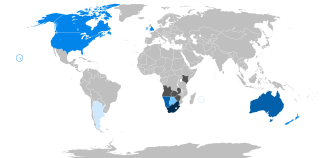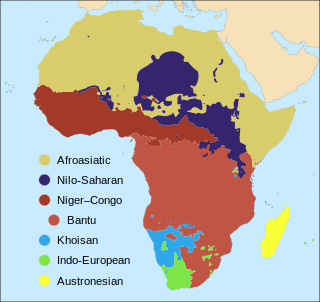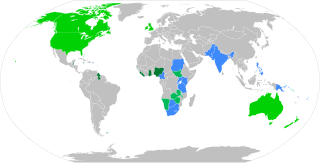.References
- ↑ Ethnographic Survey of Africa. International African Institute. 1956. p. 11.
- ↑ Dihoff, Ivan R. (1983). Current Approaches to African Linguistics. Foris. p. 50. ISBN 9789070176570.
Sillok are an ethnic group of Sudan, living in Blue Nile state. They speak the Sillok language (Aka), a Nilo-Saharan language, however most also speak Arabic. They are a subgroup of the Berta people [1] and live on Mount Silak (Jebel Silak), also spelt Mount Sillok, which is south of the Ingessana hiills, near Keti. [2]

Afrikaans is a West Germanic language spoken in South Africa, Namibia, and, to a lesser extent, Botswana, Zambia, and Zimbabwe. It evolved from the Dutch vernacular of Holland spoken by the European settlers and their slaves in South Africa, where it gradually began to develop distinguishing characteristics during the course of the 18th century. It is considered by most linguists to be partially, rather than fully, a creole language. Afrikaans linguistics researchers maintain that Afrikaans is only partially creole.

The Berber languages, also known as the Amazigh languages, are a branch of the Afroasiatic language family. They comprise a group of closely related languages spoken by the Berbers, who are indigenous to North Africa. The languages were traditionally written with the ancient Libyco-Berber script, which now exists in the form of Tifinagh.

French is a Romance language of the Indo-European family. It descended from the Vulgar Latin of the Roman Empire, as did all Romance languages. French evolved from Gallo-Romance, the Latin spoken in Gaul, and more specifically in Northern Gaul. Its closest relatives are the other langues d'oïl—languages historically spoken in northern France and in southern Belgium, which French (Francien) largely supplanted. French was also influenced by native Celtic languages of Northern Roman Gaul like Gallia Belgica and by the (Germanic) Frankish language of the post-Roman Frankish invaders. Today, owing to France's past overseas expansion, there are numerous French-based creole languages, most notably Haitian Creole. A French-speaking person or nation may be referred to as Francophone in both English and French.

South African English is the set of English language dialects native to South Africans.

Tswana, also known by its native name Setswana, and previously spelled Secoana in English, is a Bantu language spoken in Southern Africa by about 8.2 million people. It belongs to the Bantu language family within the Sotho-Tswana branch of Zone S (S.30), and is closely related to the Northern Sotho and Southern Sotho languages, as well as the Kgalagadi language and the Lozi language.

The languages of Africa are divided into several major language families:
The Nilotic peoples are peoples indigenous to the Nile Valley who speak Nilotic languages. They inhabit South Sudan, Sudan, Ethiopia, Uganda, Kenya, the Democratic Republic of the Congo, Rwanda, and Tanzania. Among these are the Burun-speaking peoples, Karo peoples, Luo peoples, Ateker peoples, Kalenjin peoples, Datooga, Dinka, Nuer, Atwot, Lotuko, and the Maa-speaking peoples.

Khoekhoen are the traditionally nomadic pastoralist indigenous population of southwestern Africa. They are often grouped with the hunter-gatherer San peoples. The designation "Khoekhoe" is actually a kare or praise address, not an ethnic endonym, but it has been used in the literature as an ethnic term for Khoe-speaking peoples of Southern Africa, particularly pastoralist groups, such as the !Ora, !Gona, Nama, Xiri and ǂNūkhoe nations.

The Bantu expansion is a hypothesis of major series of migrations of the original Proto-Bantu-speaking group, which spread from an original nucleus around West-Central Africa across much of sub-Saharan Africa. In the process, the Proto-Bantu-speaking settlers displaced or absorbed pre-existing hunter-gatherer and pastoralist groups that they encountered.

Speakers of English are also known as Anglophones, and the countries where English is natively spoken by the majority of the population are termed the Anglosphere. Over two billion people speak English as of the 2000s, making English the largest language by number of speakers, and the third largest language by number of native speakers.

The Eastern Jebel languages are a small subfamily belonging to the Eastern Sudanic subgroup of Nilo-Saharan. They are spoken in the hills of An Nil al Azraq province in eastern Sudan

Modern Standard Arabic (MSA) or Modern Written Arabic, terms used mostly by linguists, is the variety of standardized, literary Arabic that developed in the Arab world in the late 19th and early 20th centuries; occasionally, it also refers to spoken Arabic that approximates this written standard. MSA is the language used in literature, academia, print and mass media, law and legislation, though it is generally not spoken as a first language, similar to Contemporary Latin. It is a pluricentric standard language taught throughout the Arab world in formal education, differing significantly from many vernacular varieties of Arabic that are commonly spoken as mother tongues in the area; these are only partially mutually intelligible with both MSA and with each other depending on their proximity in the Arabic dialect continuum.
The languages of Ethiopia include the official languages of Ethiopia, its national and regional languages, a large number of minority languages, as well as foreign languages.
Sillok (Aka) is a Nilo-Saharan language spoken by the Sillok people of Sudan. It is spoken by around 300 people in Blue Nile state, specifically on Mount Silak, southwest of the Ingessana hills.

F/X2 is a 1991 American action thriller film directed by Richard Franklin and starring Bryan Brown and Brian Dennehy. It is a sequel to the 1986 film F/X. This was Franklin's final American film before he returned to his native Australia.

Bantu people are the speakers of Bantu languages, comprising several hundred indigenous ethnic groups spread over a vast area from Central Africa, to Southeast Africa, and to Southern Africa.
Silak is a village in Darjazin-e Sofla Rural District, Qorveh-e Darjazin District, Razan County, Hamadan Province, Iran. At the 2006 census, its population was 263, in 52 families.

Terengganurians, Terengganuans or Terengganu Malays, are a Malay ethnic group native to the state of Terengganu, on the east coast of Peninsular Malaysia. Besides Terengganu, they can also be found in the neighbouring states of Pahang, Johor and their descendants can also be found in the Anambas Islands in Indonesia. As of 2010, it is estimated that the population of Terengganuan Malays are around 1.1 million people, which forms 94% of Terengganu state's population, making them the dominant ethnic group in the state.
Cathy R. Silak is the former dean of the Concordia University School of Law in Boise, Idaho. She is a former justice of the Idaho Supreme Court and the Idaho Court of Appeals.